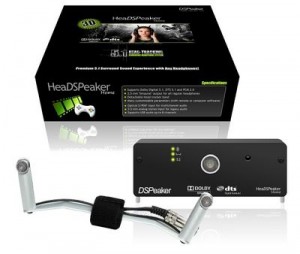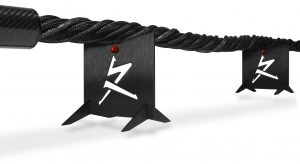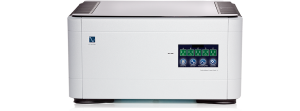A power strip is simply a "splitter" of the power supply—it goes in with a single cable, and it goes out via several outputs/sockets. Acoustic Revive in Europe offers one model, featuring four sockets. We would like to present you the latest version called the Absolute.
This is the first part of a two-part test. Later we will present also the Absolute power cable and an entire Absolute system with the power strip, power cable and two filters.
"To filter or not to filter?" I was stopped with this question for much longer then it would take to chose one of these two answers. If it were as simple as it might seem, it would have taken me about five seconds plus a handshake.
The thing happened during the Audio Video Show 2018, on Friday evening, in the corridor of the Radisson Blu Sobieski hotel, and the question was asked by one of the High Fidelity readers who wanted to know if it was better to connect his beloved headphone system to a power strip, in which there are no filtering elements, is it better to reach for one of the power supply conditioners. The answer should be simple and unambiguous, and in reality it requires reaching for something other than just knowledge—to our expectations and imaginations about an absolute sound.
Each of these ways has its advantages and disadvantages, that's just life. Each of these techniques in one system works better, in others worse—again: as in life. But even more important is that their success or failure is largely related to the condition of the whole installation in the building, as well as to how noisy (distorted) is the supply voltage. There are so many variables that the best solution is to try again and again, which will bring us closer to one of two answers: "to filter" or "not to filter."
RTP-4EU Absolute
It is worth knowing, however, that in addition to technical premises, the issue related to the power supply of audio devices is particularly saturated with ideology. If you heard the influence of some power strip, conditioner with passive filtration or active conditioner and "befriended" with the changes introduced by one of these methods, you will look for similar ones regardless of the circumstances I mentioned earlier.
This is also the case with Mr. Ken Ishiguro, designer-artist, music lover and expert, Sekiguchi Machine engineer, a thriving company producing industrial equipment, which is a mother company of the Acoustic Revive brand; Mr. Ishiguro is its CEO. His first products, RD-1 demagnetizers from 2002 and later RD-2, as well as the RTP-6 power strip from the same year, won a lot of awards in the audio press, and licenses for them were bought by Furutech, which presented their own versions.
The cooperation between these two Japanese companies is extremely tight. The new version of the RTP-4EU Ultimate strip, which I have been using in my reference system for several years, the RTP-4EU Absolute model, has Furutech's elements in its DNA; power and IEC sockets. The former were developed jointly by both companies and these are the latest NCF versions.
The Nanocrystalline Formula (NFC) is a material with 'active' properties. First of all, it generates negative ions that eliminate static electricity in the socket and secondly it converts thermal energy into easily extinguished infrared waves. This material was combined by Furutech with nanoceramic particles and carbon powder, that have piezoelectric properties. Their copper contacts are also rhodium-plated.
These sockets were bolted to the milled aluminum block in the variant chosen by Mr. Ishiguro based on listening sessions. The whole bottom is flooded with material suppressing high-frequency interference, also suppressing the bar mechanically. Connections are made with Triple-C cables, that we already know from the Power Reference Triple-C review. These are solid-core cables with an oval 2.8 x 2.4 mm cross-section in silk and Teflon insulation.
The interior was also filled with a material resembling wool—another material minimizing RF interference, used in industrial devices for special purposes. On the bottom of the strip's housing, as well as on the IEC socket, Mr. Ishiguro glued small discs of mountain crystal—a thing we have known for a long time (more HERE). A unit prepared for me featured his signatures placed everywhere and some special signs made by this artist, as if during some secret rituals.
The new strip is smaller than the older one, it has other sockets and cabling and additional vibration damping elements were used in it. This however, is still a power strip without any electronic filtering components, with four power sockets, set on four small feet.
HOW WE LISTENED TO IT
In my case, the test was somewhat easier because of the fact that I am using an older version of this strip, i.e. the RTP-4EU Ultimate model. The sockets in it come from Oyaide and the IEC from Furutech; all are rhodium-plated. The test was performed as a comparison between these two power strips, both used for my entire system, both plugged to the same Furutech wall outlet.
And the system is powered by three different cables: from the wall to the strip leads a 2.5-meters Acrolink Mexcel 7N-PC9500, the same model, but 2-meters long, feeds the Ayon Audio Spheris III preamplifier. The Soulution 710 power amplifier is powered by the Acoustic Revive Power Reference cable and the Ayon Audio CD-35 High Fidelity Edition SACD player by the 2-meters Siltech Triple Crown cable. The preamplifier and power amplifier also utilize passive Acoustic Revive RAS-14 Triple-C filters.
During the test both strips were placed on Acoustic Revive RST-38H anti-vibration platform.
SOUND
Recordings used for the test (a selection)
- Okihiko Sugano Recording Works, Stereo Sound SSSA 1, "Stereo Sound Reference Record", SACD/CD, (2007) w: Mori Shima, Okihiko Sugano Recording Works Discography, Stereo Sound Publishing Inc., Tokyo 2007 (more HERE)
- Aquavoice, Silence, Zoharum ZOHAR 168-2, Master CD-R (2018); review HERE
- Dave Grusin, Discovered Again! Plus, Sheffield Lab/Lasting Impression Music LIM XR 002, XRCD24 (1976/2003)
- Matt Dusk, JetSet Jazz, Magic Records 771 961 3, CD (2018)
- Mayo Nakano Piano Trio, MIWAKU, Briphonic BRPN-7007GL, Extreme Hard Glass CD-R (2017); more HERE
- N. Maeda, N. Maeda Meets 5 Saxophones, Audio Lab. Record/Octavia Records OVGL-00026, SACD/CD (1976/2012)
- Tord Gustavsen Trio, Changing Places, ECM/Universal Music K.K. UCCE-9185, SHM-CD (2003/2008)
- Vangelis, Blade Runner, Atlantic Records/Audio Fidelity AFZ 154, "Limited Edition | No. 2398", SACD/CD (1998/2013)
At first glance, both power strips I listened to, ie the RTP-4eu Ultimate, which I have been using for several years and which is my reference device for all other strips and conditioners I test, and its latest version, the RTP-4EU Absolute, they are very similar. They both feature longitudinal aluminum housings with four power sockets screwed to them, one IEC socket, and the whole is supported by four feet. And that's it. The changes that Mr. Ken Ishiguro introduced to the new version are negligible from the measurement point of view. The differences are of course still there, it's a still the world of classical mechanics (Newton's), but I am sure that engineers with classical education would not even know what to do with the measurements results.
And yet the sound is as different as the sound of my Harbeth M40.1 speakers and the latest version, the M40.2 40th Anniversary Edition and changes in an equally spectacular way as when I replace a standard CD with a Platinum SHM-CD, or a Master Gold CD-R with Extreme Hard Glass CD-R. It's sort of the same sound, it has the same components, there is a similar structure of the sound. And we perceive it in a different way, "see" a different picture in our head, or react to it differently on an emotional level.
The Absolute strip is like a precision tool. It delivers an incredibly fast sound that has no room for even minor, hesitation, or delay. This is realistically fast sound, it is not just hardening of the attack. Fast in the whole body. The sound is therefore immediate in such a way that large groups "move," whole layers, and not individual sounds. Hardening of the attack and emphasizing the top of the band become quickly tiring. Music with the Absolute strip does something else—it energizes.
I started with how fast this sound is, because it is in my opinion, the most important feature of the new Acoustic Revive strip. However, this conclusion comes later, after some time, when we finally understand what we can hear. The first impression is about something else—it's a strip delivering an open and dynamic sound, in which the bass is under more strict control, both in terms of timbre, fullness and decay length, but not as saturated as with the older model, or with the Verictum Cogitari.
In which it reminded me the differences between Shunyata Research conditioners, Denali T and Triton v3 models (more HERE). It's amazing how improvements introduced by newer, better, or just different materials and components, improvements introduced by different companies, companies using different techniques, translate into similar changes. That is, moving from a very good "base" component to a higher, better one, similar elements change—and in both Shunyata and in Acoustic Revive. As if there was some sort of a "consensus" about what a good sound is.
The Absolute strip is very fast, we already know it, it also shortens the bass slightly, controlling it better—that's been also already said. For many listeners, something else will be more important—it is a strip with a precise, strong, and open top. In a poorly composed system, i.e. too light and too aggressive sounding, it will be a step in a wrong direction. There, it is better to use something sounding warmer, with a stronger bottom—for example the Ultimate model. In well-balanced systems we shall hear not brightening, but higher resolution, and thus better differentiation—differentiation of all elements of the presentation.
With some recordings, the sound with the new strip was even darker. But not because it modified something in them, and because it allowed me to better hear the properties of these CDs. That SOMETHING that one can hear every time one switches from one component to another, better one was nicely described by The Chord Company, a British cables manufacturer, one of those companies that I respect for professionalism. In the description of her top ChordMusic series, we read:
Why do we offer a cable of this class? The answer is quite simple—only when working on the most expensive high-end cables we learn something new about them. Taylon (new dielectric - editor's note) has highlighted the problems previously masked by phase distortions. The improved resolution enabled us to manufacture also higher quality less expensive series.
source: The Chord Company
Can you see it? A new 'better' solution exposes problems that earlier were hidden by the 'worse' solution, which now need to be corrected. The RTP-4EU Absolute works in this way—it is not bright or too light sound, but these two elements if present in the system will be uncovered by this strip. When we solve these problems of the system strip will deliver speed, dynamics, resolution, but on a completely new level, and maybe two levels up. Same thing will happen with recordings. After some time, when we "learn" this new sound with both the system and discs, we will come to a conclusion that the Japanese "absolute" strip deepens the sound and adds silkiness to it, saturating the colors more intensely.
In my case it was a disc entitled Changing Places by Tord Gustavsen Trio. The disc was released by ECM and I have the Japanese version on SHM-CD. Both the ECM label and the SHM-CD format are often associated with precise but rather bright sound. This is a misunderstanding—the ECMs (as well as the SHM-CDs) "own" sound is resolving, accurate, but certainly not "bright." On the contrary, the amount of information we get with these releases means that most of them sound incredibly deep and dark. Like Tord Gustavsen's album.
After switching to the newer Absolute strip, the sound of the disc has become even more velvety and denser. The older Ultimate version sounds warm, slightly dark and has a low and strong bass, slightly colored towards saturation. It sounds beautiful, engaging and soothing, but there is a slight coloration. The Absolute cleaned it out, the extension was not so impressive anymore, but it was closer to what we know from reality. I am not saying that the music played at home is supposed to sound "live-like," it is complete nonsense, but simply that within the accepted convention of mechanically re-played music, the Absolute's presentation is more real and less "made."
In this way, we already have virtually all the elements that make up the performance of Mr. Ishiguro's new strip. There is resolution, so the performance is deeper, more extensive and better fills the space between speakers. The bass is a bit shorter, so there is no "gut massage," neither with the electronics on the Aquavoice Silence, nor with the big-band on the Matt Dusk album. However, you must know that Ultimate emphasized this range. It was nice, but less real.
And there is a great space with the Absolute. Or actually 'imaging' because 'space' is the Ultimate's advantage. The new strip extends the instruments' bodies deeper into the stage and fills the space with them in front of us better. There is an incredible energy and freshness in this sound. There is dynamics and speed that create a natural image, less "studio-like" and more "live-like," of course within the limits to which we have to get used to at home.
Everything is also denser and more tangible. Although it is a warm sound that is usually associated with "tangibility," only a truly resolving sound is really so; warmth nicely simulates this feature but it does nothing more. The Absolute at first seems to play in a more reserved way and a bit quieter. But turn up the volume knob by 1-2dB, and you'll hear that everything is calmer with it, but also clearer. It's actually a denser and internally richer sound than in almost all power conditioning products I know.
Summary
As I've already said, the RTP-4EU Absolute power strip is like a tool. Initially, it will not be as comfortable in our hands as the old one. In the old one some clattering, looseness, inaccuracies were something natural to us, something what we got used to. I would even say that while rationalizing our attachment to such a tool, we usually say that it has a "soul."
With the Absolute you do not have to rationalize anything. This is one of the best power supply components for audio systems, equally good in terms of sonic performance as the already mentioned Shunyata Research conditioner. I'm still a huge fan of the Ultimate version, especially paired with the Asura Quality Recovery System Level 1 platform. Now I hear even better how it creates its own sound. In order to move forward, I must choose the path pointed out by the Absolute.
Technical specifications (according to manufacturer)
- Number of outlets: 4
- Mains input voltage: 230V/50 Hz
- Dimensions (H x WS x D): 880 x 700 x 265 mm
- Weight: 2.5 kg
Acoustic Revive RTP-4EU Absolute Power strip AC
Price (in Poland): 26 990 PLN
Contact: Yoshi Hontai | MuSon Project, Inc.
MADE IN JAPAN
Provided for test by: MUSON PROJECT
Text: Wojciech Pacuła
Images: Wojciech Pacuła | Acoustic Revive
Translation: Marek Dyba













































